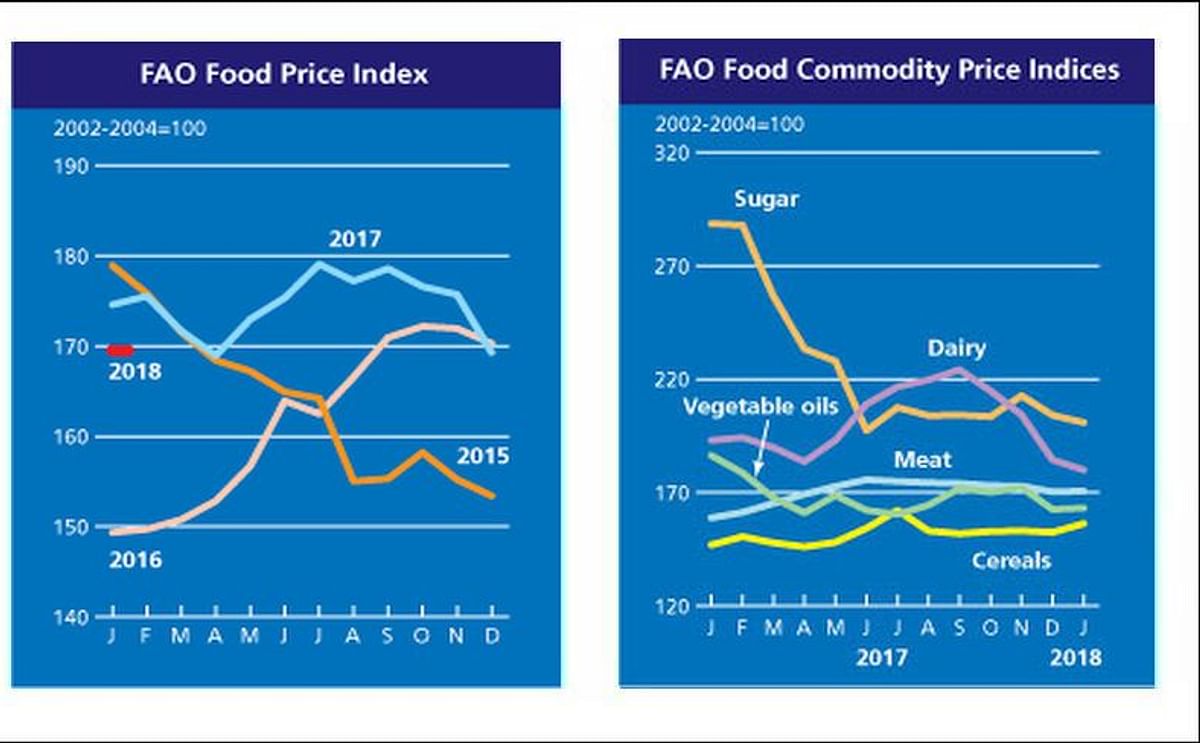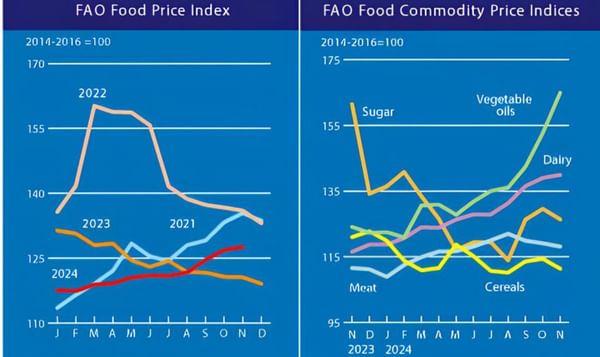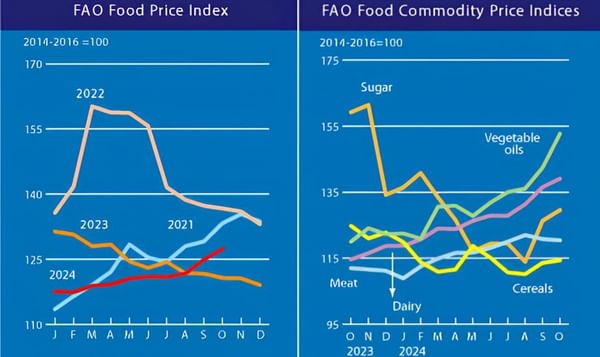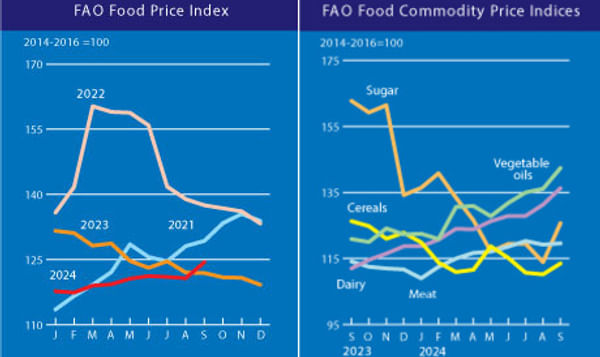The FAO Food Price Index averaged 169.5 points in January 2018, nearly unchanged from December 2017
FAO Food Price Index steady in January 2018

The FAO Food Price Index (FFPI) averaged 169.5 points in January 2018, nearly unchanged from December 2017 but almost 3 percent below the corresponding period last year. While firmer prices were registered for cereals and vegetable oils in January, dairy and sugar values were generally weaker and meat quotations remained steady.
The FAO Cereal Price Index averaged 156.2 points in January, up almost 2.5 percent (4 points) from December and 6.3 percent from January 2017. Despite large supplies, wheat and maize prices received some support from a weaker US dollar as well as concerns over weather. International rice values continued to firm up in January, sustained mainly by renewed Asian demand.
The FAO Vegetable Oil Price Index averaged 163.1 points in January, virtually unchanged from December, as moderate rises in palm oil values were outweighed by weakening prices for other oils, notably sunflower and rapeseed oils. International palm oil quotations strengthened as global import demand picked up just when seasonal production declines were looming in Southeast Asia.
By contrast, rapeseed oil prices were pressured by both excess supplies in the EU and larger than expected availabilities in North America and Australia, while those of sunflower oil were affected by sluggish global import demand.
The FAO Dairy Price Index averaged 179.9 points in January, down 2.4 percent (4.5 points) from December 2017. Although this decline pushed the index further down for the fourth consecutive month, it is still 41 percent higher than its trough reached in April 2016. During the month, international price quotations for butter and cheese declined, while those of milk powders increased.
Abundant milk supplies in the northern hemisphere and Australia represented a factor that heavily influenced global dairy prices, including the declines in butter and cheese prices. However, the possibility for seasonal milk production in New Zealand to be lower than expected lent support to Whole Milk Powder (WMP) prices. Skim Milk Powder (SMP) values also increased, mostly on account of strong import demand.
The FAO Meat Price Index averaged 170.6 points in January, almost unchanged from its slightly revised value for December 2017. At this level, the index is 7.4 percent higher than its January 2017 value and 19.5 percent below its all-time high reached in August 2014. International price quotations for poultry and pigmeat continued to slide due to higher export availabilities amid weak import demand. Prices of bovine meat were up marginally, reflecting lower quantities offered for sale from Oceania, while those of ovine meat rose supported by strong international demand, especially from Asia and the Middle East.
The FAO Sugar Price Index averaged almost 201 points in January, down 1.6 percent (3.2 points) from December and as much as 30.4 percent below the corresponding month last year. International sugar quotations remained under downward pressure mostly because of strong production outcomes in major producing countries and, hence, ample export availabilities.
The FAO Cereal Price Index averaged 156.2 points in January, up almost 2.5 percent (4 points) from December and 6.3 percent from January 2017. Despite large supplies, wheat and maize prices received some support from a weaker US dollar as well as concerns over weather. International rice values continued to firm up in January, sustained mainly by renewed Asian demand.
The FAO Vegetable Oil Price Index averaged 163.1 points in January, virtually unchanged from December, as moderate rises in palm oil values were outweighed by weakening prices for other oils, notably sunflower and rapeseed oils. International palm oil quotations strengthened as global import demand picked up just when seasonal production declines were looming in Southeast Asia.
By contrast, rapeseed oil prices were pressured by both excess supplies in the EU and larger than expected availabilities in North America and Australia, while those of sunflower oil were affected by sluggish global import demand.
The FAO Dairy Price Index averaged 179.9 points in January, down 2.4 percent (4.5 points) from December 2017. Although this decline pushed the index further down for the fourth consecutive month, it is still 41 percent higher than its trough reached in April 2016. During the month, international price quotations for butter and cheese declined, while those of milk powders increased.
Abundant milk supplies in the northern hemisphere and Australia represented a factor that heavily influenced global dairy prices, including the declines in butter and cheese prices. However, the possibility for seasonal milk production in New Zealand to be lower than expected lent support to Whole Milk Powder (WMP) prices. Skim Milk Powder (SMP) values also increased, mostly on account of strong import demand.
The FAO Meat Price Index averaged 170.6 points in January, almost unchanged from its slightly revised value for December 2017. At this level, the index is 7.4 percent higher than its January 2017 value and 19.5 percent below its all-time high reached in August 2014. International price quotations for poultry and pigmeat continued to slide due to higher export availabilities amid weak import demand. Prices of bovine meat were up marginally, reflecting lower quantities offered for sale from Oceania, while those of ovine meat rose supported by strong international demand, especially from Asia and the Middle East.
The FAO Sugar Price Index averaged almost 201 points in January, down 1.6 percent (3.2 points) from December and as much as 30.4 percent below the corresponding month last year. International sugar quotations remained under downward pressure mostly because of strong production outcomes in major producing countries and, hence, ample export availabilities.
Like to receive news like this by email? Join and Subscribe!
Join Our Telegram Channel for regular updates!
精选企业
Sponsored Content
Sponsored Content
Sponsored Content
Sponsored Content
Sponsored Content











